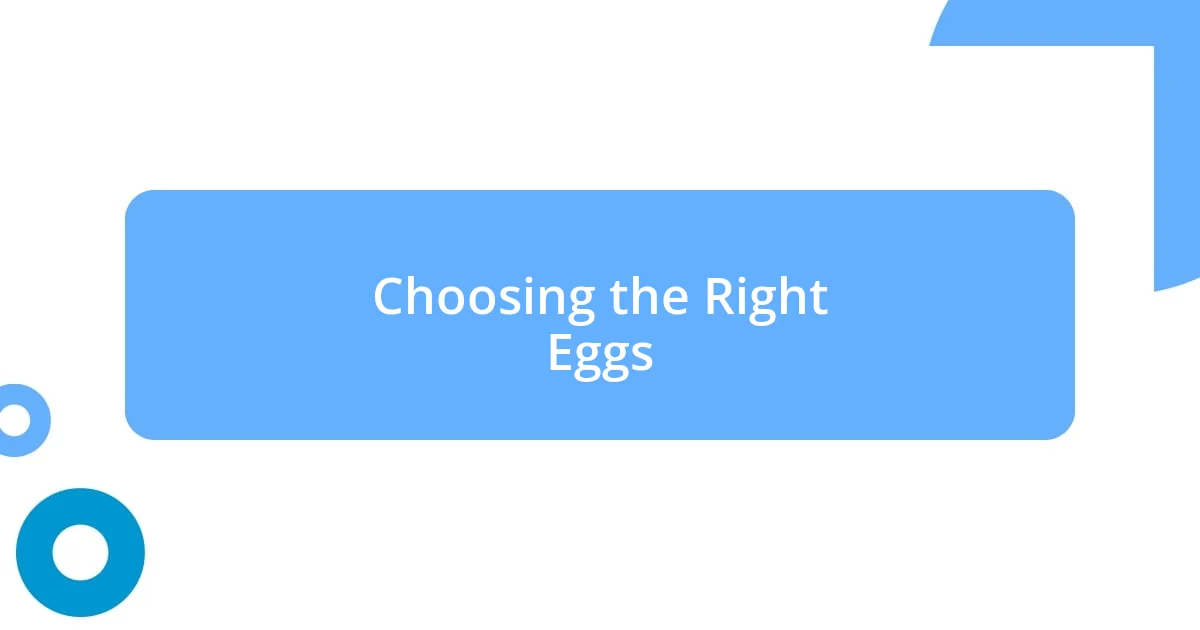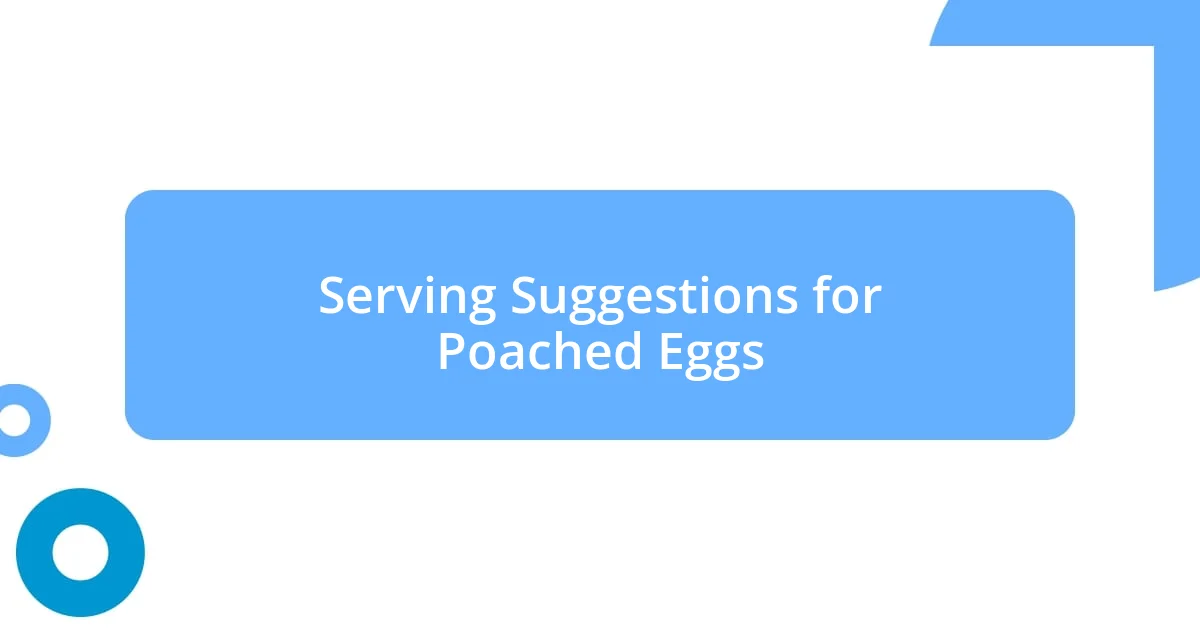Key takeaways:
- Using fresh, quality eggs is crucial for achieving beautifully poached eggs, as they hold their shape better and enhance flavor.
- Proper technique, including a gentle simmer, the addition of vinegar, and timing, significantly influences the texture and appearance of the poached egg.
- Creative serving suggestions, such as avocado toast, sautéed greens, or hollandaise sauce, can elevate the dish and enhance the dining experience.

Understanding Poached Eggs
Poached eggs are a delightful culinary creation that often appear deceptively simple but, in reality, require a bit of finesse. I remember the first time I tackled this seemingly easy dish; I was flooded with excitement, feeling like a gourmet chef in my own kitchen. But my initial attempts often resulted in unattractively splattered eggs, leaving me wondering—what was I missing?
The magic of a perfectly poached egg lies in its method, which involves gently simmering the egg in water. The whites should wrap around the yolk, creating that beautiful, soft texture that we all crave. I’ve found that using the freshest eggs not only enhances the flavor but also improves the overall outcome. Have you ever tried cracking an egg straight from the farm? The difference is palpable, not just in taste, but also in how the egg behaves in the water.
Timing is crucial, too. I often set a timer to keep myself accountable. There’s something satisfying about watching the egg cook, bubbling away and transforming into a delicate masterpiece. Instead of simply following a set time, I’ve learned to trust my instincts—experimenting a bit with the cooking times based on how I like my yolks. It’s that personal touch that makes the experience truly rewarding.

Essential Tools for Poaching
When it comes to poaching eggs, having the right tools can make all the difference. I’ve discovered that each tool plays its own role in achieving that perfect, Instagram-worthy result. While it might seem like you can get by with just a pot and a spoon, investing in a few key items will elevate your poaching game remarkably.
Essential tools to consider for poaching:
- Wide, Shallow Pan: This helps create a larger surface area for the eggs, allowing them to spread out without crowding.
- Slotted Spoon: Ideal for retrieving your eggs without damaging their delicate form.
- Fresh Eggs: Yes, this is a tool of sorts, as fresher eggs hold their shape better in water.
- Vinegar: A splash added to the water can help the egg whites set more quickly, keeping your egg beautifully intact.
- Timer: A reliable kitchen timer ensures you’re cooking your eggs to your preferred doneness without the guesswork.
I remember the first time I bought a proper slotted spoon. It felt like a small victory in my culinary journey, allowing me to lift my eggs effortlessly out of the bubbling water. That moment when you see the egg rise to the surface, with its perfectly formed white encasing a golden yolk, is hard to beat. It’s those simple victories that add joy to the process and keep me coming back to the stove.

Choosing the Right Eggs
Choosing the right eggs is essential for creating a flawless poached egg. I always opt for farm-fresh eggs when possible. There’s something special about their vibrant yolks that adds both color and richness to my dish. I remember preparing brunch for friends once; their first bite of my poached eggs drew gasps of delight. It hit me then how much the egg’s quality influenced their experience.
When considering eggs, look at the labeling. Organic, free-range, and pasture-raised eggs not only boast better flavor but also support animal welfare. I usually find that free-range eggs produce a firmer white that holds together beautifully when poached, making the culinary process feel more satisfying. Have you ever tasted the difference? It’s startling how much flavor and texture come from a simple choice.
Lastly, the age of the eggs plays a role, too. Fresher eggs, less than a week old, typically result in those beautiful, cohesive poached forms. I learned this the hard way during a family gathering when I used older eggs, and the outcome was less than ideal. Watching my perfect plans for brunch dissolve into a messy pool of whites was a lesson I cherished. Now, I keep my egg supply fresh, ensuring I have the best ingredients to create something extraordinary.
| Type of Egg | Characteristics |
|---|---|
| Conventional | Often lacks flavor, whites may spread more in water. |
| Organic | Better flavor, a firmer structure, and more nutrient-dense yolks. |
| Free-Range | Improved yolk color and texture; great poaching results. |
| Pasture-Raised | Highest quality, rich taste, excellent for poaching. |

Step by Step Poaching Process
For the perfect poached egg, I like to start by filling my wide, shallow pan with about three inches of water. Bringing it to a gentle simmer is crucial; I often think of it like preparing a cozy bath for my eggs. If the water’s boiling too rapidly, you might end up with ragged edges—definitely not what I want when aiming for that pristine look!
Once the water reaches the ideal temperature, I add a splash of vinegar. You might wonder, does vinegar really make a difference? From my experience, it’s a game changer! I’ve noticed that the egg whites coagulate much faster, ensuring they cling to the yolk instead of spreading out. It reminds me of a cooking class where we experimented without vinegar—it was a great lesson in why the little details truly matter.
When it’s showtime, I gently crack my fresh egg into a small bowl first. This allows me to control the placement in the water, which is key for maintaining its beautiful shape. I delicately slide the egg in, and as I watch it cook, there’s an exhilarating anticipation. Timing is everything here, and I love using my trusty kitchen timer to achieve that perfect runny yolk. Who doesn’t relish that moment when the timer dings, and you unveil your masterpiece?

Common Poaching Mistakes
It’s easy to make mistakes when poaching eggs, even for seasoned cooks. One common blunder I often see is rushing the process. I once impatiently dropped an egg into boiling water, thinking that a quicker cook would yield better results. Instead, I was met with a shattering mess of egg whites dispersed all over the pan. Have you ever experienced the disappointment of a ruined egg? Slower, more methodical approaches yield that perfect, cloud-like result, and I now advocate for a gentle simmer every time.
Another mistake happens during the preparation stage: skipping the vinegar. I find it fascinating how a mere splash can change everything. There have been times when I chose to omit it, thinking it wasn’t necessary, only to end up with a poached egg that looked more like a slimy blob. The realization hit hard—these small additions can have an immense impact. Wouldn’t you agree that the taste and texture are far more appealing when the egg firms up nicely with a little help from vinegar?
Lastly, I’ve noticed that many people overlook the importance of timing. Picture this: you’re cooking breakfast in the morning rush, you throw the eggs into the water, but forget to keep an eye on the clock. I’ve been there, and it always ends with overly cooked yolks—not the gooey perfection I aim for. My solution? I use the timer not just for myself, but as a gentle reminder of the art involved in the poaching process. Isn’t it rewarding to know you can master not just the technique, but also the perfect timing?

Tips for Perfectly Poached Eggs
To achieve the perfect poached egg, make sure your eggs are super fresh. I remember one time when I tried poaching older eggs, and the result was, well, an absolute disaster! The whites barely held together, and the yolks lost that beautifully bright color. Fresh eggs not only poach better but also result in that charmingly rich flavor we crave. Have you ever experienced the distinction between a fresh egg and one that’s been hanging around? It’s truly night and day.
Another tip I swear by is creating a gentle whirlpool in the simmering water before adding the egg. This might sound a bit extra, but trust me; it’s a game changer! I like to take a spoon to stir the water in a circle, which helps the egg white wrap around the yolk. I vividly recall my first attempt using this method—it felt like watching a culinary magic trick as the egg took shape right before my eyes. It’s those little tricks that bring a sense of fun to cooking, isn’t it?
Finally, resist the temptation to poke or prod the egg while it’s cooking. When I first started poaching, I was so curious that I kept checking on my eggs, and every time I did, I disturbed the delicate cooking process. I learned that patience is key; just let the egg do its thing! The anticipation builds, and I often find myself daydreaming about how perfect that runny yolk will be, reminding myself that good things come to those who wait. Does anyone else feel that little rush of excitement as they wait for their perfect poached egg?

Serving Suggestions for Poached Eggs
When it comes to serving poached eggs, my go-to is a classic avocado toast. The creamy texture of the avocado pairs beautifully with the soft, runny yolk. I still recall the first time I added a sprinkle of flaky sea salt and a dash of chili flakes on top—it transformed my breakfast from bland to sensational! Have you ever experienced that “aha” moment when a simple tweak changes everything?
Another delightful option is to serve poached eggs over a bed of sautéed greens. I once made a breakfast bowl with spinach, garlic, and a splash of lemon juice. The vibrant greens, topped with a perfectly poached egg, created a colorful dish that not only looked appealing but also felt nourishing. Does anyone else find that bright colors make food taste better? It’s like a feast for the eyes!
For something a little more indulgent, consider pairing your poached eggs with a buttery hollandaise sauce. The first time I tried it, I felt like I was dining in a fancy restaurant right at home. Just the right amount of richness elevates the dish to a whole new level. Have you ever tried pouring that velvety sauce over a poached egg? It’s pure decadence on a plate!














